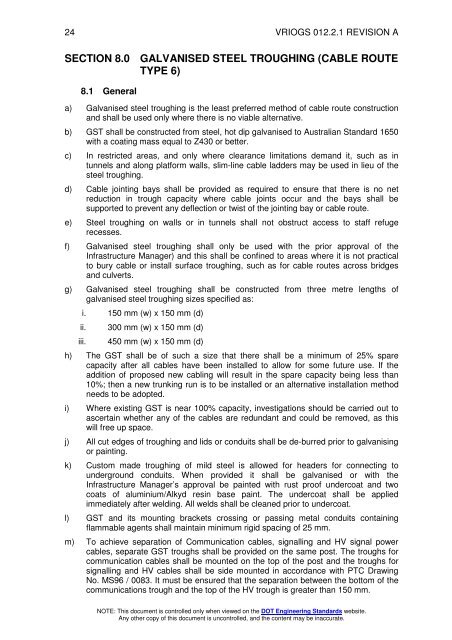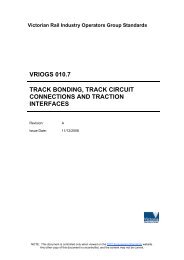VRIOGS 012.2.1 - Public Transport Victoria
VRIOGS 012.2.1 - Public Transport Victoria
VRIOGS 012.2.1 - Public Transport Victoria
Create successful ePaper yourself
Turn your PDF publications into a flip-book with our unique Google optimized e-Paper software.
24 <strong>VRIOGS</strong> <strong>012.2.1</strong> REVISION A<br />
SECTION 8.0 GALVANISED STEEL TROUGHING (CABLE ROUTE<br />
TYPE 6)<br />
8.1 General<br />
a) Galvanised steel troughing is the least preferred method of cable route construction<br />
and shall be used only where there is no viable alternative.<br />
b) GST shall be constructed from steel, hot dip galvanised to Australian Standard 1650<br />
with a coating mass equal to Z430 or better.<br />
c) In restricted areas, and only where clearance limitations demand it, such as in<br />
tunnels and along platform walls, slim-line cable ladders may be used in lieu of the<br />
steel troughing.<br />
d) Cable jointing bays shall be provided as required to ensure that there is no net<br />
reduction in trough capacity where cable joints occur and the bays shall be<br />
supported to prevent any deflection or twist of the jointing bay or cable route.<br />
e) Steel troughing on walls or in tunnels shall not obstruct access to staff refuge<br />
recesses.<br />
f) Galvanised steel troughing shall only be used with the prior approval of the<br />
Infrastructure Manager) and this shall be confined to areas where it is not practical<br />
to bury cable or install surface troughing, such as for cable routes across bridges<br />
and culverts.<br />
g) Galvanised steel troughing shall be constructed from three metre lengths of<br />
galvanised steel troughing sizes specified as:<br />
i. 150 mm (w) x 150 mm (d)<br />
ii.<br />
iii.<br />
300 mm (w) x 150 mm (d)<br />
450 mm (w) x 150 mm (d)<br />
h) The GST shall be of such a size that there shall be a minimum of 25% spare<br />
capacity after all cables have been installed to allow for some future use. If the<br />
addition of proposed new cabling will result in the spare capacity being less than<br />
10%; then a new trunking run is to be installed or an alternative installation method<br />
needs to be adopted.<br />
i) Where existing GST is near 100% capacity, investigations should be carried out to<br />
ascertain whether any of the cables are redundant and could be removed, as this<br />
will free up space.<br />
j) All cut edges of troughing and lids or conduits shall be de-burred prior to galvanising<br />
or painting.<br />
k) Custom made troughing of mild steel is allowed for headers for connecting to<br />
underground conduits. When provided it shall be galvanised or with the<br />
Infrastructure Manager’s approval be painted with rust proof undercoat and two<br />
coats of aluminium/Alkyd resin base paint. The undercoat shall be applied<br />
immediately after welding. All welds shall be cleaned prior to undercoat.<br />
l) GST and its mounting brackets crossing or passing metal conduits containing<br />
flammable agents shall maintain minimum rigid spacing of 25 mm.<br />
m) To achieve separation of Communication cables, signalling and HV signal power<br />
cables, separate GST troughs shall be provided on the same post. The troughs for<br />
communication cables shall be mounted on the top of the post and the troughs for<br />
signalling and HV cables shall be side mounted in accordance with PTC Drawing<br />
No. MS96 / 0083. It must be ensured that the separation between the bottom of the<br />
communications trough and the top of the HV trough is greater than 150 mm.<br />
NOTE: This document is controlled only when viewed on the DOT Engineering Standards website.<br />
Any other copy of this document is uncontrolled, and the content may be inaccurate.

















